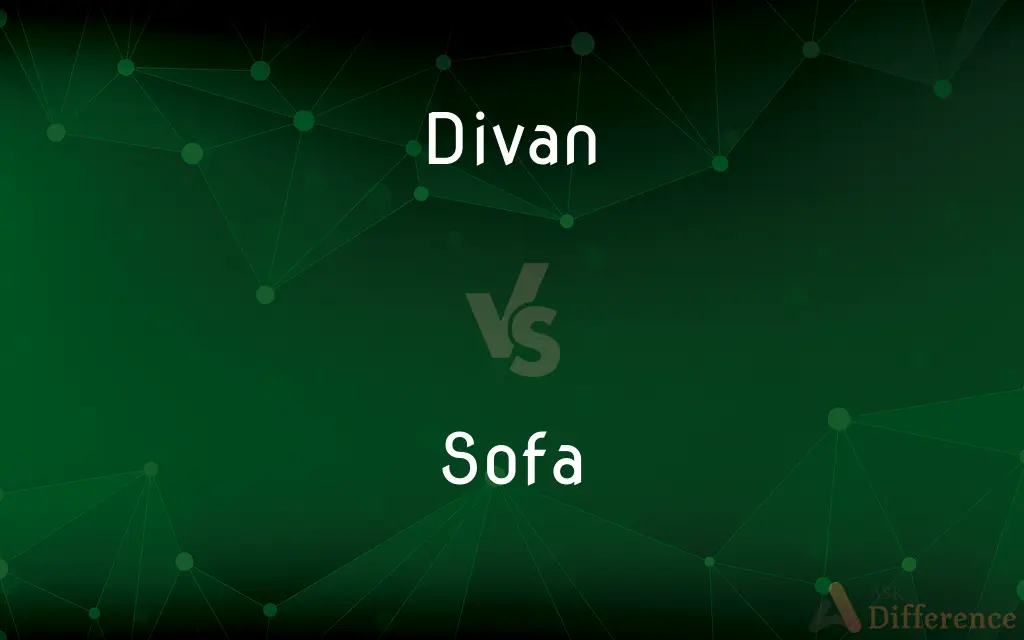Divan vs. Sofa — What's the Difference?
By Tayyaba Rehman — Updated on November 6, 2023
A divan is a couch-like piece without a back or arms, often used as a bed, while a sofa is a cushioned bench with armrests and a back.

Difference Between Divan and Sofa
Table of Contents
ADVERTISEMENT
Key Differences
Divans are furniture pieces that originated in the Middle East, typically used as low couches and sometimes fitted against two walls in a corner. They may be placed against a wall, where cushions are used to provide back support. Divans often serve dual purposes, acting as both a seat and a possible sleeping area.
Sofas are western-style seating arrangements designed for comfort and aesthetic appeal in living spaces. Unlike divans, sofas have a built-in back and armrests and are often the central furniture piece in living rooms. They are used primarily for seating and are rarely designed for sleeping purposes.
A divan can be recognized for its lack of structural arms and back; it is often placed against a wall or in a corner to add the necessary support for the user. This minimalistic style allows for flexibility in use and placement within a room, and it often serves as a multipurpose piece.
In contrast, a sofa typically stands freely in the middle of a room and is designed to anchor a living space, providing a comfortable seating area for multiple people. Sofas come in various styles, including sectional, chesterfield, and loveseat, reflecting the diversity in design preferences.
The primary function of a divan is to offer a simplistic seating area, which can often be transformed into a bed with the addition of a mattress. This feature makes divans a popular choice in spaces that require versatility, such as studio apartments or guest rooms.
ADVERTISEMENT
Sofas, on the other hand, are less about versatility and more about providing a dedicated and comfortable seating space. They are not typically designed to be converted into beds, focusing instead on the comfort and support needed for sitting, including ergonomic features and plush cushions.
Comparison Chart
Design
No built-in back or arms.
Has a built-in back and arms.
Primary Function
Seating that can double as a bed.
Seating only, not meant for sleeping.
Location in a Room
Often placed against walls.
Can stand freely in the room.
Cultural Origin
Middle Eastern.
Western.
Cushions
Requires separate cushions for back support.
Typically comes with fixed cushions.
Compare with Definitions
Divan
A piece of furniture that doubles as a bed
Guests often sleep on the divan in the study.
Sofa
A comfortable seating area for multiple people
They cuddled on the sofa during the movie night.
Divan
A long low sofa without a back or arms
She draped a colorful throw over the divan.
Sofa
A piece of furniture that comes in various styles and sizes
They chose a sectional sofa for the game room.
Divan
A seating option often associated with psychoanalysis
Freud's patients would recline on the divan.
Sofa
A decorative and functional item for lounging
She fell asleep on the plush sofa after work.
Divan
A divan or diwan (Persian: دیوان, dīvān) was a high government ministry in various Islamic states, or its chief official (see dewan).
Sofa
A cushioned bench with a back and arms
The new velvet sofa was the living room's centerpiece.
Divan
A bed consisting of a base and mattress but no footboard or headboard.
Sofa
Furniture often used as the main seating in a living room
The leather sofa had room for the entire family.
Divan
A long, low sofa without a back or arms.
Sofa
A long upholstered seat typically with a back and arms.
Divan
A legislative body, council chamber, or court of justice in the Ottoman Empire or elsewhere in the Middle East.
Sofa
A raised area of a building's floor, usually covered with carpeting, used for sitting.
Divan
A long backless sofa, especially one set with pillows against a wall.
Sofa
An upholstered seat with a raised back and one or two raised ends, long enough to comfortably accommodate two or more people.
Divan
A counting room, tribunal, or public audience room in Muslim countries.
Sofa
To furnish with one or more sofas.
Divan
The seat used by an administrator when holding audience.
Sofa
To seat or lay down on a sofa.
Divan
A government bureau or council chamber.
Sofa
A long seat, usually with a cushioned bottom, back, and ends; - much used as a comfortable piece of furniture.
Let fall the curtains, wheel the sofa round.
Divan
(also dī-văn) A coffeehouse or smoking room.
Sofa
An upholstered seat for more than one person
Divan
(also dī-văn) A book of poems, especially one written in Arabic or Persian by a single author.
Divan
A Muslim council of state, specifically that of viziers of the Ottoman Empire that discussed and recommended new laws and law changes to a higher authority (the sultan).
Divan
The council chamber where this court is held; by extension, any court of justice.
Divan
Any council or assembly.
Divan
A couch- or sofa-like piece of furniture made of a mattress lying against the wall and either on the floor or an elevated structure.
Divan
(dated) An establishment that serves cigars and coffee, and may offer other amenities such as books, newspapers, and chess.
Divan
A collection of poems, especially one written by an author in Arabic or Persian.
Divan
A book; esp., a collection of poems written by one author; as, the divan of Hafiz.
Divan
In Turkey and other Oriental countries: A council of state; a royal court. Also used by the poets for a grand deliberative council or assembly.
Divan
A chief officer of state.
Divan
A saloon or hall where a council is held, in Oriental countries, the state reception room in places, and in the houses of the richer citizens. Cushions on the floor or on benches are ranged round the room.
Divan
A cushioned seat, or a large, low sofa or couch; especially, one fixed to its place, and not movable.
Divan
A coffee and smoking saloon.
Divan
A long backless sofa (usually with pillows against a wall)
Divan
A Muslim council of state
Divan
A collection of Persian or Arabic poems (usually by one author)
Divan
A Muslim council chamber or law court
Divan
A couch-like seat traditionally used in the Middle East
The divan in the corner was piled with pillows.
Divan
A versatile piece of furniture for sitting or lying
The divan by the window made a cozy reading nook.
Common Curiosities
What is a divan used for?
A divan is used for seating and sometimes as an additional bed.
What are the typical features of a sofa?
A sofa typically features a back, arms, and cushioned seating for comfort.
Can a divan be used in any room?
Yes, divans are versatile and can be used in living rooms, studies, or bedrooms.
How many people can a sofa seat?
Sofas can typically seat two to four people, depending on the size.
Do divans come with storage options?
Yes, some divans have built-in drawers underneath.
Can sofas be customized?
Yes, many stores offer customizable sofa sizes and fabric options.
What's the best way to support your back on a divan?
Use large cushions or place the divan against a wall for back support.
What's the difference in price between a divan and a sofa?
Prices vary widely, but sofas tend to be more expensive due to their size and complexity.
Are divans comfortable for daily use?
With the right cushions, divans can be comfortable for both sitting and occasional sleeping.
Are sofas suitable for small spaces?
Some sofas, like loveseats, are designed for small spaces.
Is a sofa bed the same as a divan?
No, a sofa bed has a pull-out mattress, while a divan may not.
Can both divans and sofas be part of a living room set?
Yes, both can be incorporated into living room sets, depending on the style and layout.
How do you clean a divan?
Cleaning a divan involves vacuuming and spot-cleaning, similar to a sofa.
Do divans require assembly?
Some divans may require assembly, especially if they have storage options.
Are sofas or divans better for formal settings?
Sofas are typically considered more formal due to their structured design.
Share Your Discovery

Previous Comparison
Mirk vs. Murk
Next Comparison
Eruption vs. RuptureAuthor Spotlight
Written by
Tayyaba RehmanTayyaba Rehman is a distinguished writer, currently serving as a primary contributor to askdifference.com. As a researcher in semantics and etymology, Tayyaba's passion for the complexity of languages and their distinctions has found a perfect home on the platform. Tayyaba delves into the intricacies of language, distinguishing between commonly confused words and phrases, thereby providing clarity for readers worldwide.














































